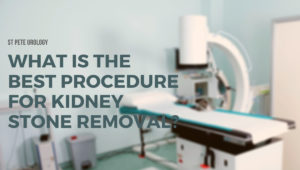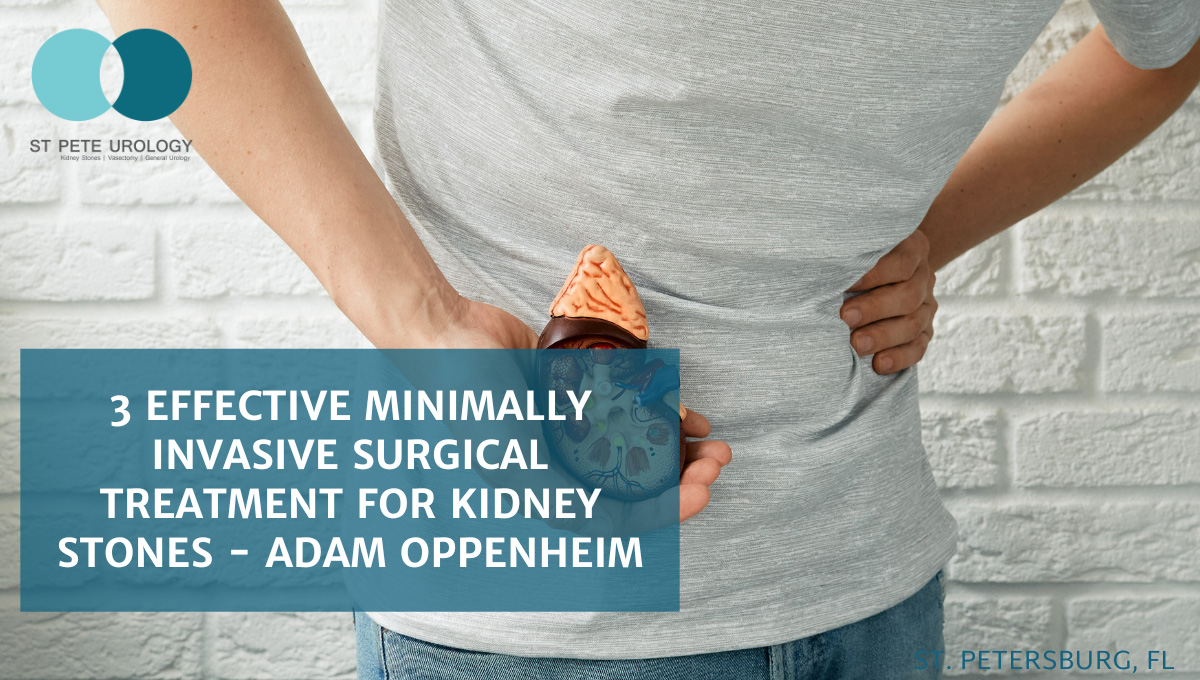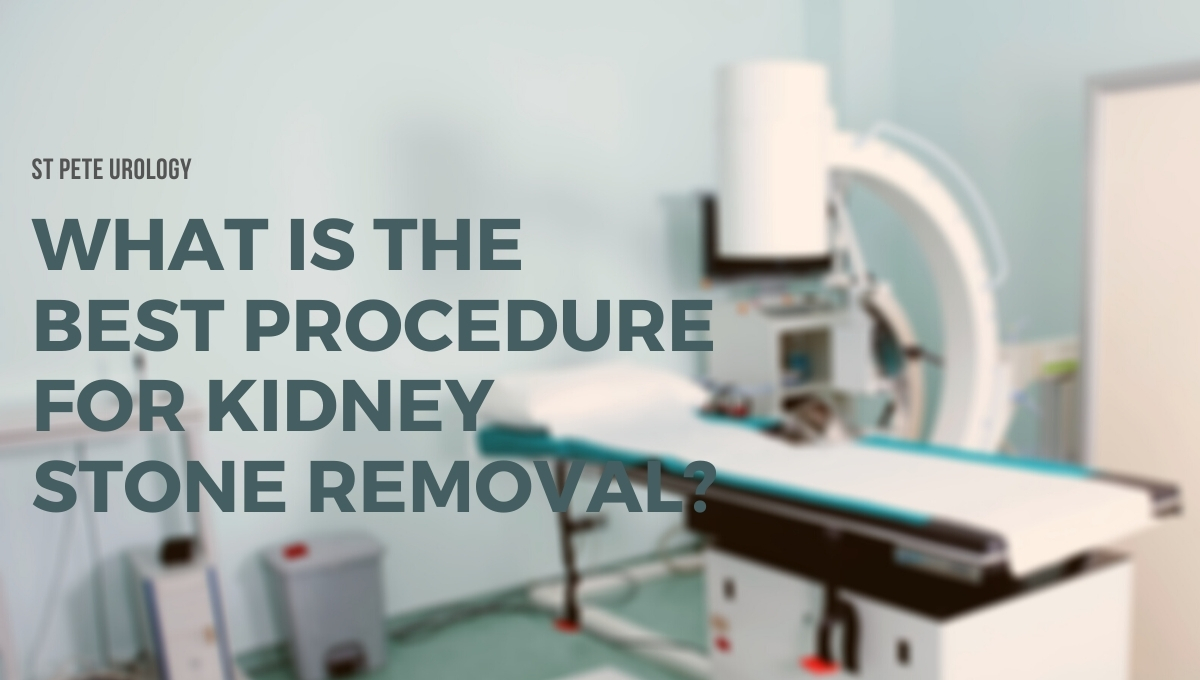There are three effective minimally invasive surgical treatments for kidney stones: Shockwave Lithotripsy, Ureteroscopy, and Percutaneous Nephrolithotomy.
Continue readingWhat is the Best Procedure for Kidney Stone Removal?


For kidney stones that are larger and block your urinary tract or cause unbearable pain, you may need treatment to break down and remove the stones. If you are vomiting and dehydrated, urgent treatment is necessary.
So what is the best procedure for kidney stone removal?
For larger stones causing excruciating pain or that may not pass on their own, surgery is typically the best treatment. There are four surgical procedures your urologist may consider: shockwave lithotripsy, ureteroscopy, percutaneous nephrolithotomy, and robot-assisted surgery. The best surgical procedure for your kidney stones will depend on their type and location.
You will need surgical kidney stone removal if:
- You have a lot of pain
- You have large stones that cannot pass on their own
- Your stones are blocking urine flow out of your kidneys
- You have recurrent urinary tract infections due to stones
At St Pete Urology, our urologists are highly trained and experienced in a full range of surgical procedures for removing kidney stones. We conduct minimally-invasive procedures which guarantee faster healing.
The procedure we perform on a patient will depend on the nature and location of the stone, the patient’s overall health, and other factors.
We ensure that you get the best possible care as quickly as possible, from surgery through recovery.
How are the surgical procedures performed?
1. Shock Wave Lithotripsy
Shock wave lithotripsy (SWL) is a procedure in which kidney stones are targeted using sound waves and X-rays. The stones are broken down before they are passed naturally in urine. This non-invasive procedure is used for small to medium-sized kidney stones, usually less than two centimeters in size, softer, and located in the ureter.
During the procedure, you lie on a table and receive medicine to limit pain and discomfort before high-energy shock waves are aimed at the stone from the outside. No cuts are made in your skin as the waves go through and break the stones into smaller pieces. Your urologist may insert a tube in your ureter, called a stent, which will aid in passing the stones. The procedure will take about an hour and you are free to go home the same day. Recovery time for shockwave lithotripsy is relatively short, so you will be able to return to normal activities within a few days.
2. Ureteroscopy
For bigger stones, your urologist may consider ureteroscopy. For this procedure, a small scope, called a ureteroscope, is inserted into the kidney via the bladder. When the stone is in the upper part of the ureter and kidney, your urologist will use a more flexible ureteroscope. If the stones are in the lower portion of the ureter near the bladder, a rigid scope may be used. Ureteroscopy is an outpatient procedure done without incision and under general or spinal anesthesia.
At St Pete Urology, one of the most common surgeries to treat kidney stones is ureteroscopy with Holmium laser lithotripsy. During this procedure, the urologist inserts a narrow, flexible ureteroscope through your urethral opening and passes it through the bladder to reach the stone. The stone is then collected from the location or broken up using a small laser fiber and removed.
3. Percutaneous nephrolithotomy
Percutaneous nephrolithotomy is a minimally-invasive procedure in which a surgeon makes a small incision, usually at the back or side to create a tunnel directly to the kidney to break and remove a large or irregularly shaped stone. Once an incision is made, an optical instrument, called a nephroscope, is inserted through the incision to reach the stone. The stone is broken down into small pieces and drawn out. This procedure is ideal for kidney stones that are big (larger than 2 centimeters), numerous, too dense, or located in a hard-to-reach area in the kidney or ureter. A stent is inserted to help with the excretion of urine as you heal from the surgery. You may need an overnight stay in the hospital after the procedure and can expect to recover in two to four weeks.
4. Robot-assisted stone removal
Kidney stones can also be removed using the da Vinci surgical system, particularly if you were born with a kidney drainage problem (ureteropelvic junction obstruction) or have complicated stones that cannot be removed successfully using other surgical methods.
This robotic surgical system gives urologists a high-resolution and three-dimensional view of small areas. It allows for an increased range of motion and the ability to make more precise incisions, which ensure less scarring. Patients who undergo this procedure recover more quickly and spend fewer days in the hospital, compared to those who have had traditional open surgery.
Why have your kidney stone removal at St Pete Urology?
At St Pete Urology, our urologists frequently treat patients with kidney stones of different types, locations and sizes. We perform hundreds of kidney stone surgeries every year, using mostly minimally invasive and robotic procedures.
Your condition will be managed by specialists who will recommend the best procedure, apply a personalized treatment plan, and deliver top-notch follow-up care. We will see you through your recovery period and monitor your progress to make sure you are in the best of health.
For more information on kidney stone prevention, diagnosis and treatment, visit the St Pete Urology website.
3 Effective Minimally Invasive Surgical Treatment For Kidney Stones
Minimally-invasive surgical treatments
At St Pete Urology, we offer surgical treatment for kidney stones, focusing on minimally-invasive procedures even for the largest stones. Most operations for smaller stones can be done as same-day surgeries, giving patients greater flexibility and a faster return to their work and other routine activities. For larger stones, the planning and execution of the procedures may take a little more time, but with the use of small incisions only large enough to allow insertion of thin tubes, fiber-optic lights, cameras and other tiny surgical tools, we are able to ensure significantly less pain, less scarring, shorter hospital stay, faster recovery and increased accuracy than with traditional open surgery for the stones.
There are three main minimally-invasive techniques for removal of kidney stones. The least invasive being extracorporeal shockwave lithotripsy, followed by ureteroscopy then lastly percutaneous nephrolithotomy. The choice of a surgical technique depends on multiple factors, including the type of stone, size and location, medications taken by the patient, other medical problems the patient may have, and patient preferences.
Extracorporeal Shockwave Lithotripsy (ESWL)
This is the most popular option for treating small and medium-sized stones. Performed in an outpatient setting with the patient placed under general anesthesia, ESWL is the least invasive and takes 20-30 minutes to be completed. During the surgical procedure, intense sound waves are focused on the kidney stone, shattering the stone with minimal effect on surrounding tissue. Smaller pieces of stones that are produced get washed out of the urinary system with the normal flow of urine, often with slight or no discomfort. ESWL is a highly effective treatment for most stones that form in the kidney or ureter.
Advantages of ESWL include:
- It’s an outpatient procedure so patients return home after a few hours.
- It offers excellent success rate with most small-sized and medium-sized stones.
- It doesn’t require incisions or invasive techniques.
- It has minimal postoperative discomfort.
- It has a fast and easy scheduling.
Limitations of ESWL include:
- It’s ineffective for stones that are very hard or resistant to breakage by shockwaves.
- It’s not appropriate for stones that are invisible on X-ray such as uric acid, monohydrate and cystine stones.
- It’s not ideal for larger stones or those located in the lower part of the urinary tract.
- It’s not appropriate for patients with certain conditions or using certain medications, such as pregnant women or patients on blood thinning medications.
Ureteroscopy
Ureteroscopy is another surgical procedure often used to treat small and medium-sized stones. The advantage it offers over ESWL is that it can treat kidney stones occurring in any part of the urinary tract. It’s a same-day procedure done after the patient is placed under general anesthesia. The procedure involves passing a small scope via the urinary opening and into the bladder then into the ureter. Once the stone is reached, it is targeted with laser so that it’s broken down into smaller pieces that are extracted out of the system or into pieces of dust left to wash out with normal urine.
Ureteroscopy is a little bit more invasive than ESWL, but it’s preferred in situations where kidney stones are too hard to respond to ESWL, or for stones that are invisible on X-ray. Ureteroscopy is also a better choice than ESWL when stones are located in the lower portion of the urinary tract, especially the region near the bladder. After the procedure, a small tube — a stent — is temporarily placed into the urinary system to help drain the kidney. The stent is totally internal, and is usually removed 3-10 days after the procedure. Stent removal is a quick and easy process done in the doctor’s office and without anesthesia.
Advantages of ureteroscopy are:
- Great results for small-sized and medium-sized stones.
- It’s an outpatient procedure.
- No incisions are necessary.
- Fast and easy scheduling.
- Done without stopping the use of blood-thinning medications.
- Effective for stones that are resistant to ESWL.
Limitations of ureteroscopy are:
- It’s not effective for very large stones.
- In some rare instances, scopes may not reach the stones.
- Many patients find the stents placed after the procedure a source of unease and discomfort.
Percutaneous Nephrolithotomy (PCNL)
For kidney stones that are exceptionally large, complex or several small stones bundled in one kidney, percutaneous nephrolithotomy (PCNL) is the most appropriate treatment. Conducted by a urologist, often assisted by an interventional radiologist, PCNL is typically an inpatient procedure requiring an overnight hospital stay. During the procedure, the urologist and radiologist collaborate to open a direct channel into the kidney’s drainage system via a small incision made in the back, often not larger than a dime.
After making the incision, the urologist uses a set of specialized tools to break the stones into pieces, which are then plucked out or vacuumed out of the kidney. With the procedure completed, a drainage stent or tube is left in place for temporary drainage of the kidney. For stones that are unusually large or complicated, the urologist may schedule a second “clean-up” surgery. In most cases, patients leave the hospital after PCNL within 24 hours of the procedure. And despite PCNL being a more invasive procedure than ureteroscopy and ESWL, it remains an effective and safe treatment that sees a high level of patient satisfaction.
Advantages of PCNL are:
- It is the gold standard treatment for very large or really complex stones.
- It is the most appropriate surgery for patients with a number of small stones bundled in one kidney.
- It clears most kidney stones fully in one procedure.
- It is highly safe and effective.
Limitations of PCNL are:
- A drainage tube or stent is necessary after the procedure, which may be uncomfortable for most patients.
- It is not appropriate for patients on blood-thinning medications.
- It is more invasive and so an overnight stay in hospital is a necessity.
- Though it clears most stones in one procedure, a repeat procedure may be necessary for the largest or most complex stones.
At St Pete Urology, we perform hundreds of minimally-invasive surgeries for kidney stones every year. We have several surgeons with extensive training, skill and experience in ESWL, ureteroscopy and PCNL, delivering excellent outcomes even for the most difficult kidney stones. Our collaborative, compassionate and patient-centered approach to care also means our patients enjoy utmost comfort and convenience throughout their procedures. So if you have symptoms of what you suspect to be kidney stones, don’t hesitate to come see us. We fix kidney stones safely and effectively. For more information on the prevention, diagnosis and treatment of kidney stones, visit the “St Pete Urology” site.



